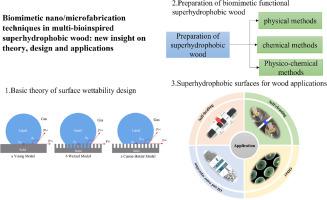当前位置:
X-MOL 学术
›
Surf. Interfaces
›
论文详情
Our official English website, www.x-mol.net, welcomes your feedback! (Note: you will need to create a separate account there.)
Biomimetic nano/microfabrication techniques in multi‐bioinspired superhydrophobic wood: New insight on theory, design and applications
Surfaces and Interfaces ( IF 6.2 ) Pub Date : 2024-03-17 , DOI: 10.1016/j.surfin.2024.104217 Wenlong Sun , Jun Li , Jian Qiu , Yi Sun
Surfaces and Interfaces ( IF 6.2 ) Pub Date : 2024-03-17 , DOI: 10.1016/j.surfin.2024.104217 Wenlong Sun , Jun Li , Jian Qiu , Yi Sun

|
The biomimetic construction of the nature-inspired superwettability systems has been extensively utilized in wood technology, but their design, preparation, and practical application still face significant challenges. Based on the principles of biomimetics, this review outlines the basic theories of design superhydrophobic surface, including Young's equation, Wenzel's equation, Cassie-Baxter's equation and contact angle hysteresis. Meanwhile, recent research advances in bioinspired superwettability wood, which mimic natural biological structures with specific functions by combining advanced preparation techniques such as physical modeling, interfacial chemistry, and physicochemical approaches, are then reviewed. Subsequently, this paper summarizes the widened scope of applications for nanoparticles in superhydrophobic systems and their impact on the study of functional enhancements in wood, including wear resistance, buoyancy, magnetism, liquid corrosion resistance and thermal stability, is summarized. From a nature-inspired perspective, an understanding of superwettability in nature serves as the principles for developing a broad spectrum biomimetic functional superhydrophobic wood and durable fluorine-free environmentally friendly solvents. Biomimetic nano/microfabrication techniques in multi‐ bioinspired Manuscript File Click here to view linked References superhydrophobic wood provides new insight on theory, design and applications for a range of wood-functionality-enhancing nanotechniques, including physical, chemical, and physicochemical approaches.
中文翻译:

多重仿生超疏水木材的仿生纳米/微加工技术:理论、设计和应用的新见解
受自然启发的超润湿性系统的仿生结构已广泛应用于木材技术中,但其设计、制备和实际应用仍然面临重大挑战。本文基于仿生学原理,概述了设计超疏水表面的基本理论,包括杨氏方程、温泽尔方程、卡西-巴克斯特方程和接触角滞后。同时,综述了仿生超润湿木材的最新研究进展,该木材通过结合物理建模、界面化学和物理化学方法等先进制备技术来模拟具有特定功能的天然生物结构。随后,本文总结了纳米粒子在超疏水体系中广泛的应用范围及其对木材功能增强研究的影响,包括耐磨性、浮力、磁性、耐液体腐蚀性和热稳定性。从自然的角度出发,对自然界超润湿性的理解是开发广谱仿生功能性超疏水木材和耐用的无氟环保溶剂的原则。多生物启发手稿文件中的仿生纳米/微加工技术点击此处查看链接参考文献超疏水木材为一系列增强木材功能的纳米技术(包括物理、化学和物理化学方法)提供了理论、设计和应用的新见解。
更新日期:2024-03-17
中文翻译:

多重仿生超疏水木材的仿生纳米/微加工技术:理论、设计和应用的新见解
受自然启发的超润湿性系统的仿生结构已广泛应用于木材技术中,但其设计、制备和实际应用仍然面临重大挑战。本文基于仿生学原理,概述了设计超疏水表面的基本理论,包括杨氏方程、温泽尔方程、卡西-巴克斯特方程和接触角滞后。同时,综述了仿生超润湿木材的最新研究进展,该木材通过结合物理建模、界面化学和物理化学方法等先进制备技术来模拟具有特定功能的天然生物结构。随后,本文总结了纳米粒子在超疏水体系中广泛的应用范围及其对木材功能增强研究的影响,包括耐磨性、浮力、磁性、耐液体腐蚀性和热稳定性。从自然的角度出发,对自然界超润湿性的理解是开发广谱仿生功能性超疏水木材和耐用的无氟环保溶剂的原则。多生物启发手稿文件中的仿生纳米/微加工技术点击此处查看链接参考文献超疏水木材为一系列增强木材功能的纳米技术(包括物理、化学和物理化学方法)提供了理论、设计和应用的新见解。



























 京公网安备 11010802027423号
京公网安备 11010802027423号